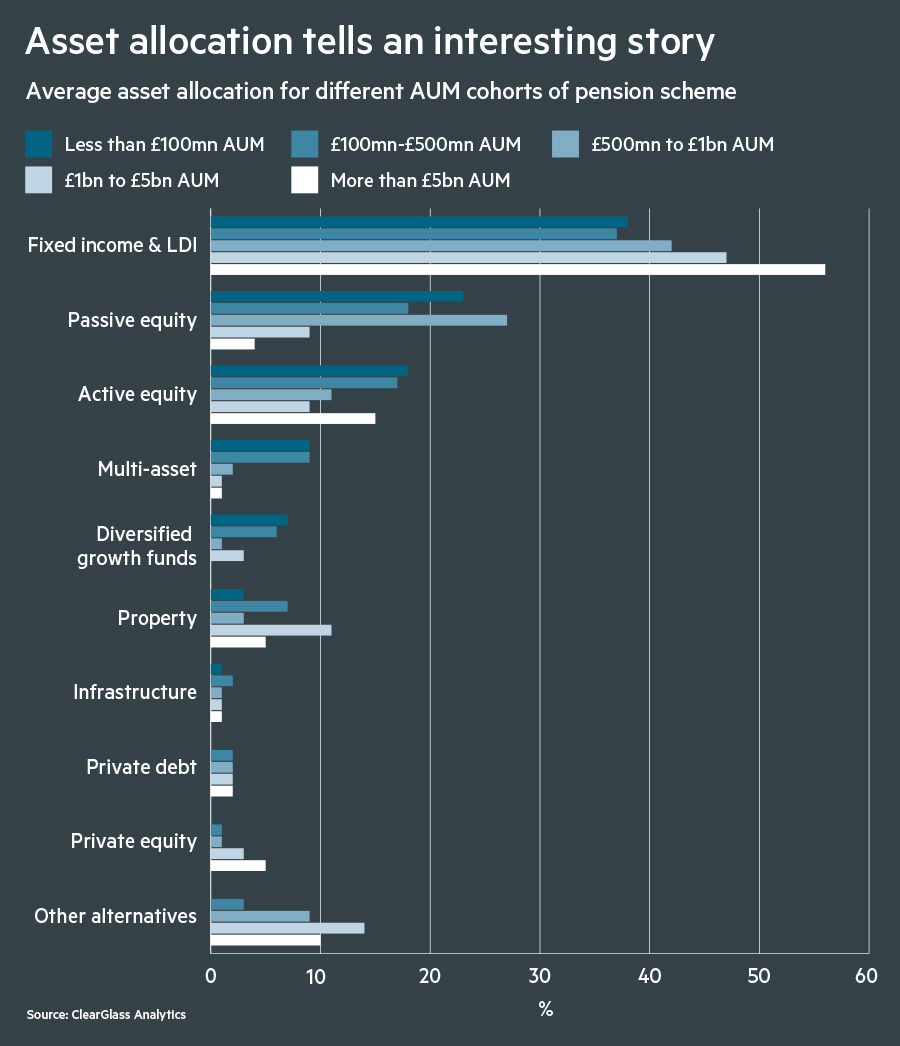Data crunch: Another edition of Dr Chris Sier’s insights into cost data collection reveals an inability of large chunks of the UK scheme universe to fulfil their engagement duties fully, leaving policymakers with tricky questions over how to proceed on environmental, social and governance rules.
Recently, I was tinkering with the asset allocation data for a large sample of defined benefit pension schemes and ‘accidentally’ came across an interesting, and possibly controversial, story relating to asset allocation.
Segmenting the data into five cohorts of increasing asset size, the results showed that as clients grow in size, the allocations to liability-driven investment and fixed income grow steadily – from 38 per cent for schemes with less than £100m in assets, to 56 per cent for schemes greater than £5bn.
Allocations to alternatives and private markets also rise, from 4 per cent for schemes with less than £100m, to 23 per cent for schemes above £5bn.
This was broadly at the expense of allocations to public equities (from 41 per cent down to 19 per cent, respectively).
The vast majority of schemes in the UK have less than £1bn, so this may not bode well for the future of voting
This leads to a couple of questions. First, why do larger funds move away from public equities?
The answer is one that has been amply demonstrated during the current Covid-19-induced equity market volatility: large pension funds that have a high allocation to public equities are at risk of large falls in asset value, which puts corporate pension sponsors at risk.
Hence the move to more ‘stable’ strategies not subject to the volatility of equity markets, such as fixed income for larger schemes and, above all, liability-matching strategies like LDI.
Second, why is there a concomitant uplift in the use of alternative and illiquid private market strategies for larger schemes? 
Larger schemes need to generate performance from somewhere, so that may be part of the explanation. But perhaps the answer also lies with the stable valuations that are delivered by private equity, infrastructure and property funds, in particular.
These valuations are actually estimates, albeit ‘educated’ estimates, and accordingly are rarely volatile and grow predictably – at least until the point of fund liquidation or redemption.
The point being, these strategies further immunise the fund – and the corporate sponsor – against market turmoil and consequent dangerous and sudden reductions in scheme asset values.
The complexities of working with private market illiquid strategies and other alternative strategies, which can be difficult to handle for less sophisticated small pension schemes, also explain the steady growth in these asset allocations as schemes get bigger.
Effective governance under spotlight
A slightly more troubling inference can be drawn about governance, and voting rights in particular.
The ability to influence corporate agendas largely comes through the voting rights linked to equity ownership. On the face of it, equity ownership remains comparatively stable across all size categories, albeit declining as schemes grow larger, as previously discussed.
But a good portion of these equities are held in passive pooled vehicles, raising the perennial issue of split voting in pooled funds.
As outlined by the Association of Member Nominated Trustees and Professor Iain Clacher from Leeds University Business School, asset owners cannot properly exercise governance rights through voting if their allocations are pooled, as opposed to buying a segregated mandate.
Active equity tells a similar story. Allocations remain pretty stable across the five size categories of pension scheme (18 per cent, 17 per cent, 11 per cent, 9 per cent and 15 per cent, respectively), but while smaller schemes predominantly use pooled vehicles, larger plans use segregated mandates.
On top of this, the average size of individual mandates increases dramatically as pensions grow in size, from £13m for pensions with less than £100m, up to £387m for schemes with more than £5bn in assets under management.
Either way, the upshot is an erosion of the ability of small schemes to exercise any governance over the assets they hold. This ability is apparently the preserve of the large and super-large schemes in the UK through the use of very large segregated active equity portfolios and private equity.
Sadly, the vast majority of schemes in the UK have less than £1bn AUM, so this may not bode well for the future of voting. But why do small schemes default to using pooled vehicles?
If the answer is that they are cheaper, then they could be wrong. This will be discussed in a future article.
Dr Chris Sier is chair of ClearGlass Analytics and led the FCA’s Institutional Disclosure Working Group






















